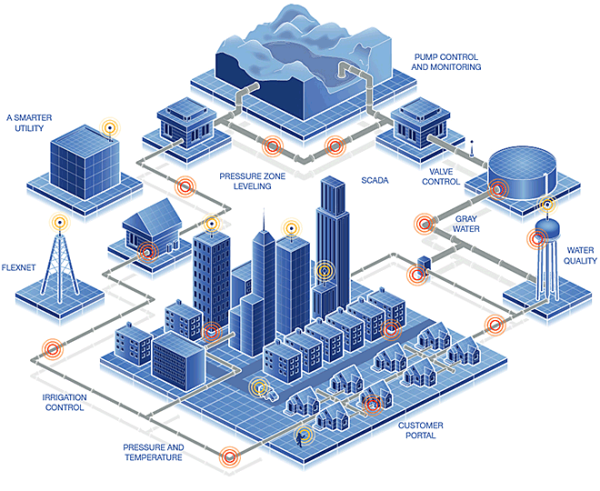Smart water: a brief history
The
smart water metering market emerged in the 2000s as water utilities responded
to global trends of using detailed and near real time data and analytics to
deliver more predictive and proactive services. The backbone of this effort is
advanced metering infrastructure (AMI) technology. AMI can provide a remote and
constant two-way data link between utilities, meters and consumers.
Communications are delivered through various technologies including power line
communications (PLC), telephony, broadband, fibre optic cable, wireless radio
frequency and cellular transmissions.
Through
a communications infrastructure of concentrators, repeaters and gateways, data
is passed between meter and utility and funnelled into analytical software that
can immediately set off pre-determined alerts. This is as well as produce
accurate billings and consumption patterns at neighbourhood and area levels,
inform other utility software such as GIS
(Geographic Information Systems) and SCADA (Supervisory Control and Data
Acquisition) and departments including customer services, pumping stations
and reservoirs. Apart from monitoring the current status of water consumption,
data can contribute towards hydraulic modelling to help predict outcomes and
changes in water distribution.
Hydraulic
modelling and network monitoring can be used by utilities to make
evidence-based network investments and upgrades. Utilities can also send
information back to the meter to perform remote upgrades and fixes, reset alert
parameters, shut off water supply during change of tenancy or reduce water flow
for unpaid accounts.
AMI vs. AMR
Smart
water metering, however, does not come without a set of questions,
uncertainties or debates. Four of the largest industry debates centre on
technology, operations, communications and the marketplace.
Water
utilities often debate whether to fully convert to AMI or run an AMR (automatic
meter reading) water grid instead. The truest of smart water grid definitions
requires AMI technology and its enabling two-way communications. Many water
utilities, however, do not see a clear advantage to AMI and feel the
"smart-lite", uni-directional communications from meter to utility
offered by AMR is fit for purpose.
This
issue needs to be addressed on a case by case basis, but water utilities,
widely known to be risk-averse, will find the most "future-proofed"
investment in AMI deployments. An example of which is the UK's most advanced
project currently being deployed by Thames Water in London. AMI offers the most
advanced capabilities and as this technology evolves and utilities grow more
sophisticated in their data analysis and operations, AMR deployments may prove
limiting; water utilities stand to gain the most through AMI.
Smart
water metering differs from smart energy metering in that smart water meters
are rarely in convenient reach of mains power supply. As a result smart water
meters are dependent on a reliable and long-lasting battery to power data
transmission. Ensuring a 15 year battery life, which matches the lifespan of
most meters, is essential for investments. Because of the proximity to water
and possible submersion of meters, batteries are sealed water-tight and are not
meant to be replaced.



评论
发表评论